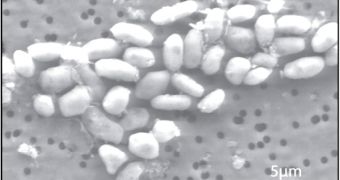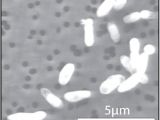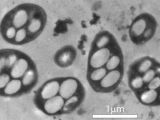In a much-anticipated press conference, that has been keeping the Internet buzzing for the last couple of days, experts announced the discovery of a new lifeform right here on Earth that does not abide by the common conception of what conditions life can survive and thrive in.
This fundamental shift in the understanding of how life can evolve could have significant influences on the way biologists conduct their search for new species, both here and in outer space.
While the announcement did not refer to little green men, as many were expecting, it does provide a new frame of reference to judge life by, and all these changes in perception were brought on by a single microbe.
What’s so outstanding about the new organism, called microbial strain GFAJ-1, is that it managed to substitute one of the chemicals experts thought were absolutely essential for the development of life – phosphorus – with another, arsenic, that was until now believed to be nothing but pure poison.
However, the new microorganism apparently does not care much for such classification, as it proved it can thrive in arsenic-rich environments, with absolutely negligible amounts of phosphorus.
The microbe was collected from the alkaline, arsenic-rich and hypersaline waters of Lake Mono, in California, and did not stand out from the crowd at first. It was only during subsequent analyses that the research team carrying out the experiment did that the experts learned about this organism’s amazing abilities.
When the investigations began, the test subject was removed from its natural habitat, and then moved to a research lab. Here, experts had set up a study chamber that emulated the conditions found in Mono Lake entirely.
Common chemicals such as vitamins and sugars were present, and nothing but trace amounts of phosphorus were left. However, the team added copious amounts of arsenic to the mix, to see how the organism would respond to these conditions.
GFAJ-1, which is a member of the Gammaproteobacteria group, proved not only capable of surviving these conditions, but managed to thrive in them, using arsenic as raw material for constructing new building blocks for its cells.
One of the most important conclusions of the research was that the bacteria were capable of incorporating the chemical into its biochemical machinery, which now lacked phosphorus.
DNA, proteins and cell membranes could all develop normally as far as the team could tell, even in the absence of one of their main constituents. This is a major leap forward in understanding the conditions that could lead to the development of life.
For example, scientists may now have to rethink their assessments of environments that were until now considered to be inhospitable for life. Exobiology, the field of science seeking to analyze potential lifeforms in places other than Earth, may also require revising.
The research group that made this amazing discovery was led by Felisa Wolfe-Simon, who holds an appointment as a NASA Astrobiology Research Fellow at the US Geological Survey (USGS), in Menlo Park, California.
“We know that some microbes can breathe arsenic, but what we've found is a microbe doing something new – building parts of itself out of arsenic,” she explains.
“If something here on Earth can do something so unexpected, what else can life do that we haven't seen yet?” she adds.
The scientist and her team published the results of their investigation in the November 2 issue of the top journal Science.
Future studies of Earth's evolution, all organic chemistry, the planet’s biogeochemical cycles, patterns of disease mitigation and general Earth system researches are but a few of the areas that could benefit from the new investigation.
“The definition of life has just expanded. As we pursue our efforts to seek signs of life in the solar system, we have to think more broadly, more diversely and consider life as we do not know it,” explains Ed Weiler.
The official is the associate administrator of the NASA Science Mission Directorate, at the American space agency's Headquarters, in Washington DC.
Back to the microorganism at hand, so to speak, one of the most remarkable things about it is that it can incorporate the arsenic not only in its most basic processes, but also in its DNA, something that hasn’t been observed anywhere else before.
After this is done, the microbe continues to grow as if nothing out of the ordinary had happened to it. Needless to say, more complex lifeforms – such as ourselves – would stand no chance in surviving such tremendous alterations to our basic chemistry.
“So far we've showed that it can do it in DNA, but it looks like it can do it in a whole lot of other biomolecules” too, Wolfe-Simon explains.
“It is the first time in the history of biology that there's been anything found that can use one of the different elements in the basic structure,” adds expert Paul Davies.
He holds an appointment as the director of BEYOND: Center for Fundamental Concepts in Science, which is based at the Arizona State University (ASU), in Tempe, Arizona.
Specialists also consider outstanding the fact that DNA itself can exist without phosphorus. The acid’s backbone, as the sides of its famous ladder are called, is made out of molecular chains containing alternating sequences of phosphate and sugars.
In turn, phosphate is obtained by combining four oxygen atoms with a phosphorus atom. The research team has yet to discover the mechanisms through which the structural integrity of DNA can be maintained in the absence of the critical element.
At the news conference tonight, Wolfe-Simon stressed that, although some traces of phosphorus remained in the bacterial colonies she grew, the amounts were utterly and completely insufficient to ensure even proper DNA backbone formation.
“I have no idea how they're doing what they're doing,” she adds. When the colonies were fed phosphorus again, they continued to grow as if the change hadn’t affected them.
A significant consequence of the fact that the bacteria can grow in the absence of the crucial chemical is reflected upon ATP (adenosine triphosphate), the main energy unit powering up all living things.
The chemical energy it carries around the body of everything living is used for metabolism inside cells. This means that all processes going on inside absolutely need it.
But the nucleotide is made up of three phosphate groups, similar to the ones described above for the DNA backbone. Figuring out how GFAJ-1 cells manage to survive without it, or with a heavily-modified form of the compound, still remains to be determined.
“Every organism that we know of uses ATP and phosphorylated DNA,” explains University of South Florida in Tampa biogeochemist Matthew Pasek, who adds on a personal note that he is absolutely amazed by the new discovery.
Indeed, even the most skeptic researchers appear to agree that, if the discovery holds to future scrutiny and peer-review processes, than it could be one of the most important findings of the new century.
Given that this study was sponsored by the NASA Exobiology/Evolutionary Biology program, the implications of the discovery for studies conducting outside of the planet cannot be ignored.
The possibility that one essential chemical can be substituted by another may give birth to an entirely new field of research. It is conceivable that other chemicals could be replaced as well, especially on other worlds, where conditions are nothing like those on Earth.
Though this is just speculation at this point, it may be possible that one of the over 500 known exoplanets features an atmosphere or a surface laden with arsenic. In light of the new findings, life could develop there.
This is a major implication for exobiology, since until now experts believed that such environment could be eliminated from the equation from the get-go. The answer may not be so clear-cut now.
Undoubtedly, some time will pass before the full extent of the new discovery is analyzed and understood. There is still a lot of research to be done on the microorganism itself, and researchers are also eager to find similar microbes and bacteria at other locations.
But what is clear even today is that we may be on the brink of a new age in understanding the origin of life, the development that followed, and the conditions in which it can thrive.
Video credit: AAAS

 14 DAY TRIAL //
14 DAY TRIAL // 

